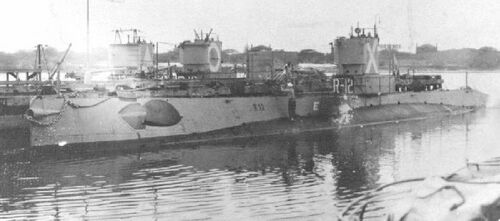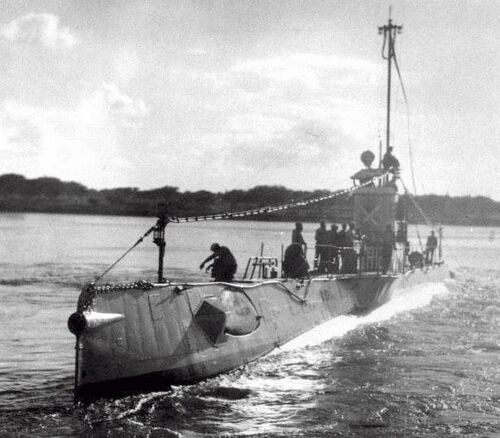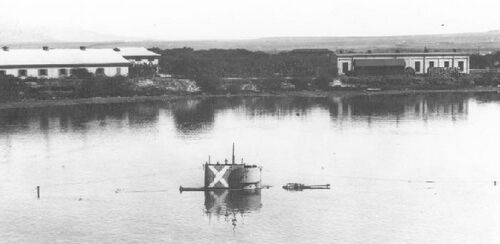R-12: Difference between revisions
Pbcjohnston (talk | contribs) Added notes section |
Pbcjohnston (talk | contribs) Added new Header |
||
| (4 intermediate revisions by 2 users not shown) | |||
| Line 1: | Line 1: | ||
[[File:R- | [[File:New Header 1 R-class.jpg]] | ||
=== <big>Notes</big> === | === <big>Notes</big> === | ||
| Line 5: | Line 5: | ||
<div style="text-align: justify;"><span style="color:#00008B">The R-12 had spent a good number of years in service to the USN. However, she spent over eight years in the reserve fleet in Philadelphia in order to keep the USN within the limits of submarine tonnage prescribed by the London Naval Treaty. As the war situation worsened in 1940 the decision was made to reactivate the R-12 and most of her sister boats and return them to the active fleet. After recommissioning R-12 operated out of a variety of ports, including New London, Bermuda, Panama, Guantanamo Bay, Key West, and Casco Bay, Maine. | <div style="text-align: justify;"><span style="color:#00008B">The R-12 had spent a good number of years in service to the USN. However, she spent over eight years in the reserve fleet in Philadelphia in order to keep the USN within the limits of submarine tonnage prescribed by the London Naval Treaty. As the war situation worsened in 1940 the decision was made to reactivate the R-12 and most of her sister boats and return them to the active fleet. After recommissioning R-12 operated out of a variety of ports, including New London, Bermuda, Panama, Guantanamo Bay, Key West, and Casco Bay, Maine. | ||
On June 12, 1943 R-12 was underway in the Florida Straits from her base in Key West. She was conducting a training mission with numerous Navy students | On June 12, 1943 R-12 was underway in the Florida Straits from her base in Key West. She was conducting a training mission with numerous Navy students and two Brazilian Navy observers onboard. At 1223 that afternoon she was running on the surface to a torpedo firing area when word was received on the bridge that the forward battery compartment was flooding. The collision alarm was sounded to alert the crew to the flooding. The disaster unfolded extremely fast. The boat nosed downward and was gone in just a few seconds. Only five men on the bridge made it off the boat before she went under. A subsequent Board of Inquiry was unable to ascertain the exact cause of her sinking, but it is likely that a failure of her riveted hull somewhere in the forward battery compartment was the cause of her loss. | ||
In the fall of 2010 the wreck of the R-12 was discovered by a team lead by explorer Tim Taylor and his wife Christine Dennison. Using a Remotely Operated Vehicle, they returned | In the fall of 2010 the wreck of the R-12 was discovered by a team lead by explorer Tim Taylor and his wife Christine Dennison. Using a Remotely Operated Vehicle, they returned in 2012, 2013, and 2014 and thoroughly documented the wreck site. While they were unable to find the exact cause of the sinking, their findings reinforced the idea of a hull failure. | ||
For more information concerning the expeditions to the wreck site, please [http://www.lost52project.org/R-12-main.html '''see this link'''] to the Lost 52 Project page for the R-12, and [http://www.r12sub.com/index.html '''this page for further information.''']</span> | For more information concerning the expeditions to the wreck site, please [http://www.lost52project.org/R-12-main.html '''see this link'''] to the Lost 52 Project page for the R-12, and [http://www.r12sub.com/index.html '''this page for further information.''']</span> | ||
| Line 14: | Line 14: | ||
[[File:R-12 with others.jpg|left|500px]] | [[File:R-12 with others.jpg|left|500px]] | ||
<div style="text-align: justify;"><span style="color:#00008B">R-12 and two of her sisters at their berths at Submarine Base Pearl Harbor, approximately 1921-1922. All have special identification markings. R-16 has the circle and R-17 has the triangle. | |||
<small>National Archives photo.</small> | |||
[[File:Red bar sub new.jpg]] | |||
[[File:R-12 backing out mooring.jpg|left|500px]] | [[File:R-12 backing out mooring.jpg|left|500px]] | ||
[[File: | <div style="text-align: justify;"><span style="color:#00008B">R-12 backing out of her mooring at Pearl Harbor, early 1920's. In modern times, all of the undeveloped land in the background has been incorporated into the massive Naval Station Pearl Harbor and has been fully developed. That was not the case in those early years. The submarine base was actually isolated away from the rest of the shipyard. | ||
<small>National Archives photo.</small> | |||
[[File:Red bar sub new.jpg]] | |||
[[File:R-12 x conning tower.jpg|left|500px]] | [[File:R-12 x conning tower.jpg|left|500px]] | ||
<div style="text-align: justify;"><span style="color:#00008B">R-12 underway off the rugged coast of one of the Hawaiian Islands, early 1920's. She doesn't appear to be anchored, but she isn't moving either. | |||
<small>National Archives photo.</small> | |||
[[File:Red bar sub new.jpg]] | |||
[[File:R-12 static dive.jpg|left|500px]] | [[File:R-12 static dive.jpg|left|500px]] | ||
<div style="text-align: justify;"><span style="color:#00008B">R-12 making a static dive in the shallow waters of Magazine Loch, Pearl Harbor, Hawaii, early 1920's. This was a function performed to check recently overhauled hull fittings to ensure they are watertight, without risking the boat in deep water. When this photo was taken the R-12 was most likely sitting on the bottom. The water depth in Magazine Loch at that time was quite shallow. | |||
<small>National Archives photo.</small> | |||
[[File:Red bar sub new.jpg]] | |||
[[File:R-12-5 color 2.jpg|left|500px]] | |||
<div style="text-align: justify;"><span style="color:#00008B">R-12 at her berth at the finger piers at Submarine Base Pearl Harbor, early 1920's. The three horns visible on her forward deck above the folded bow planes are the transducers for the Y-tube passive sonar. | |||
<small>National Archives photo.</small> | |||
[[File:Red bar sub new.jpg]] | |||
<div style="text-align: justify;"><span style="color:#00008B"> | [[File:R-12 black 1942.jpg|left|500px]] | ||
<div style="text-align: justify;"><span style="color:#00008B">R-12 underway in April, 1942 somewhere in the Caribbean, possibly off Guantanamo Bay, Cuba. This would be how the boat looked when she was lost one year later. | |||
<small> | <small>National Archives photo 80-G-7252 via Sean Hert and Navsource.org</small> | ||
[[File:Red bar sub new.jpg]] | [[File:Red bar sub new.jpg]] | ||
Latest revision as of 21:25, 16 March 2025
Notes
On June 12, 1943 R-12 was underway in the Florida Straits from her base in Key West. She was conducting a training mission with numerous Navy students and two Brazilian Navy observers onboard. At 1223 that afternoon she was running on the surface to a torpedo firing area when word was received on the bridge that the forward battery compartment was flooding. The collision alarm was sounded to alert the crew to the flooding. The disaster unfolded extremely fast. The boat nosed downward and was gone in just a few seconds. Only five men on the bridge made it off the boat before she went under. A subsequent Board of Inquiry was unable to ascertain the exact cause of her sinking, but it is likely that a failure of her riveted hull somewhere in the forward battery compartment was the cause of her loss.
In the fall of 2010 the wreck of the R-12 was discovered by a team lead by explorer Tim Taylor and his wife Christine Dennison. Using a Remotely Operated Vehicle, they returned in 2012, 2013, and 2014 and thoroughly documented the wreck site. While they were unable to find the exact cause of the sinking, their findings reinforced the idea of a hull failure.
For more information concerning the expeditions to the wreck site, please see this link to the Lost 52 Project page for the R-12, and this page for further information.

National Archives photo.

National Archives photo.

National Archives photo.

National Archives photo.

National Archives photo.

National Archives photo 80-G-7252 via Sean Hert and Navsource.org
Page created by:
Ric Hedman & David Johnston
1999 - 2023 - PigBoats.COM©
Mountlake Terrace, WA, Norfolk, VA
webmaster at pigboats dot com
